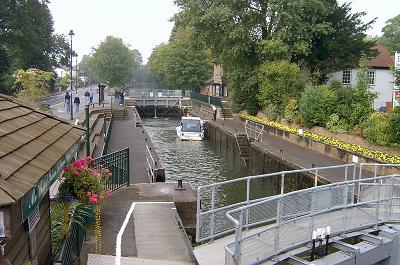Boulter’s Lock
 Boulter’s Lock
Boulter’s Lock
It is a pleasant walk along the river to Boulter’s Lock. The towpath is narrow and right up against the flowing waters. A canopy of trees provides shade from the afternoon sun and the far bank provides a wall of greenery interspersed with the occasional cottage.
The small bridge at Boulter’s Lock provides access to Ray Mill Island. This is a delightful little diversion, if only to take advantage of the ice cream kiosk. A notice on the island informs me that a walk around the perimeter will take about 1000 steps, and be a tenth of my daily requirements to maintain and improve my fitness. Seeing as I am doing a minimum 30,000 steps a day without these diversions I don’t think this will be over-stretching things, so off I go.
Cornetto in hand I spend some time at the aviaries, with their selection of birds, before sitting by the weir for a while.
The island takes its name from the Ray family who had a mill here in the 18th century.
The weir at the top of the island has a flume created for canoeists, and is also the site of a salmon ladder. In fact all of the weirs from Teddington upstream to Mapledurham have salmon ladders as part of the Thames Salmon Rehabilitation Scheme.
The scheme was started in 1979 with a target of returning naturally breeding salmon to the Thames system. The salmon cycle runs like this. The salmon spawn in upper freshwater tributaries, such as the Kennet. The eggs hatch and the first young, known as alevins, are introduced to the world. As they grow they are called parr, and after two years reach the stage known as smolt, when they attain a silvery colouring. When the smolt reach this stage they start on their long journey downstream to the sea. Once they are in to the open sea they rapidly put on weight, and in one to three years nature urges them to return to the river and begin the cycle all over again.
It seems to have been very successful in the early years, with ever-increasing numbers returning to the river from 1982 to a record year of 2003 when 338 fish were recorded. Since then numbers have rapidly declined again, and no fish were recorded in 2005, and only two in 2006.
The problem seems to be related to the condition of the river during the peak salmon run months of July and August. Low rainfall means that the flow levels are insufficient to entice the fish upstream. If you add higher than normal water temperatures the capacity of the water to hold enough oxygen becomes a further deterrent. The last two summers have seen heavy rain and this is just as bad for the fish. The swollen stormwaters carry extra silt and contaminants that the salmon see as a sort of chemical barrier, and again they are deterred from their journey.
In an attempt to regenerate the programme some 40,000 salmon smolts have been released into the River Kennet. These worked their way downstream to the sea, and it is hoped that survivors from their time in the sea will return to the Kennet to breed.
< Previous Page | Next Page >